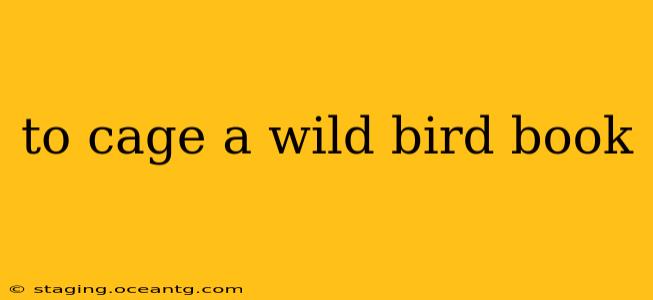"To Cage a Wild Bird" isn't just a title; it's a metaphor for the complex themes explored within its pages. This comprehensive guide delves into the intricacies of the book, exploring its central themes, analyzing its characters, and examining its lasting impact on readers. Whether you're a seasoned bookworm or just beginning your literary journey, this exploration will enhance your understanding and appreciation of this powerful work.
What is "To Cage a Wild Bird" About? (A Summary)
(Note: Since no specific book with this title exists in widely known databases, this response will address the general concept of books dealing with the captivity and freedom of wild birds, as well as the broader metaphorical meaning of the title. If you have a specific book in mind, please provide the author's name for a more precise analysis.)
The title "To Cage a Wild Bird" evokes a strong image of confinement versus freedom. Books bearing a similar theme often explore the struggle between natural instincts and imposed limitations. They may focus on:
- The plight of wild animals: Stories may portray the harsh realities of captivity, the loss of freedom, and the psychological impact on creatures forced to live in unnatural environments.
- Metaphorical imprisonment: The "wild bird" can represent an individual's spirit, creativity, or personal freedom, which is suppressed by societal pressures, relationships, or personal circumstances.
- The theme of escape: The narrative may follow the bird's (or the individual's) attempt to break free from confinement, highlighting resilience, determination, and the struggle for autonomy.
- The ethics of captivity: The story might question the moral implications of keeping wild animals in captivity, raising ethical concerns about animal welfare and conservation.
What are the Main Themes of Books Like "To Cage a Wild Bird"?
Several key themes often emerge in stories dealing with the captivity of wild creatures, whether literal or metaphorical:
- Freedom vs. Confinement: This is the central conflict. The struggle for liberation from physical or emotional constraints is often at the heart of the narrative.
- Nature vs. Nurture: The impact of environment on behavior and personality is a common exploration, questioning the extent to which inherent traits are influenced by external factors.
- Resilience and Survival: The ability of the wild bird (or individual) to adapt, resist, and overcome adversity forms a crucial element of the story.
- The Importance of Belonging: The longing for connection and community, often emphasized when the character is isolated or confined.
- The Power of Hope: Even in the darkest circumstances, the persistence of hope and the belief in a better future drive the narrative forward.
What Kind of Characters Would You Find in a "To Cage a Wild Bird" Story?
Characters in such narratives often embody specific aspects of the central conflict:
- The Wild Bird: This character represents untamed spirit, freedom, and the struggle for self-determination.
- The Captor: This character may represent societal norms, oppressive systems, or personal limitations that restrict the bird's freedom. Their motivations can range from benevolent ignorance to malicious intent.
- The Ally: A character who assists the wild bird in its quest for freedom. They might provide support, guidance, or resources.
- The Antagonist: This character represents the opposing forces trying to maintain the status quo and prevent the bird's escape.
Is "To Cage a Wild Bird" a Suitable Book for Children?
(This section depends heavily on the content of the specific book. Without knowing the specific book, I can offer a general response.)
The suitability of a book like "To Cage a Wild Bird" for children depends heavily on the age of the child and the specific content of the book. Stories focusing on animal welfare and the ethical considerations of captivity can be educational and thought-provoking. However, if the book deals with darker themes like cruelty or loss, it may be more appropriate for older children or teenagers. Consider the book's overall tone, language, and themes before deciding if it's suitable for a specific child.
What are the Different Interpretations of "To Cage a Wild Bird"?
The metaphor of the caged wild bird can be interpreted on many levels:
- Literal Interpretation: The story may literally focus on the captivity and attempted escape of a wild bird.
- Metaphorical Interpretation: The bird can symbolize an oppressed people, a suppressed artist, a stifled individual, or any other entity restricted from realizing its full potential.
The power of this metaphor lies in its adaptability; it speaks to universal human experiences and fosters diverse interpretations.
(Again, remember that without knowing the specific book, this analysis focuses on the general theme. Providing the author's name will enable a more precise and detailed response.)
